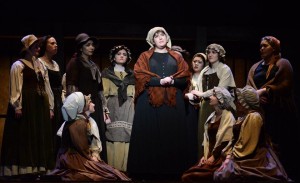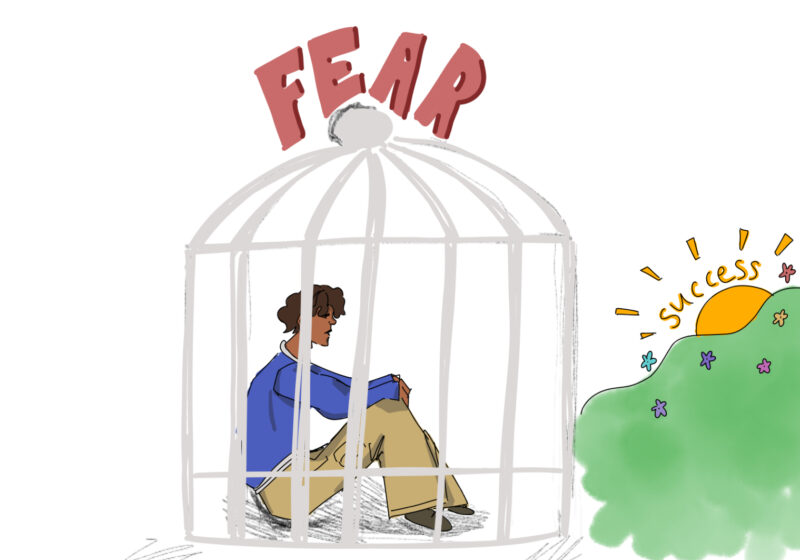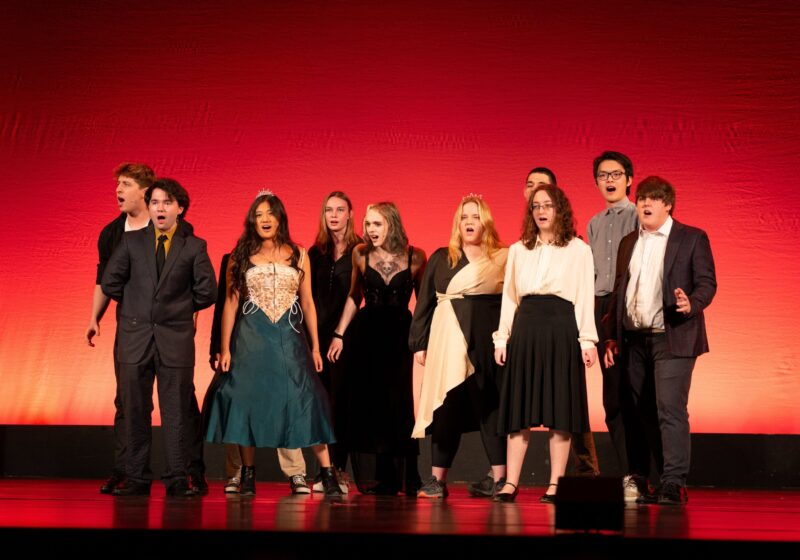“Dialogues of the Carmelites” by Francis Poulenc performed last week at Eastman, and it was an absolutely fantastic show. It was clear from the rumors in the hallways of the school leading up to the premier that the show was going to be sensational. A few days before the show opened, all of the members of the cast had the performer smile on their faces, the smile that says “I am exhausted but I have fallen in love with the show and you will too.”The set was primarily a pair of simplistic gray staircases on the left and right sides of the stage, both ending in a high platform at least 20 feet off the stage. The background was an optical illusion of sorts, with stairs twisting and turning in a continuous, mesmerizing pattern. Under the platform was a simple set of large, barn-like doors, and a gate dropped down when needed. That was it; no fancy trims or elaborate drapes. But for a show like this, anything elegant would have been very out of place and unnecessary.
The chorus was all dressed as peasants, their faces smudged with dirt. When it was first written, the show did not include an ensemble and, honestly, they didn’t sing very often. Only twice in the show did we hear their power, and on one of those occasions, they were all offstage. Instead, the chorus spread themselves in a line along the stairs and the edge of the platform, making their presence felt in the first scene and again at the end. Though I’m sure standing for so long was not the most exciting role to play, their presence added so much to the scene. It reminded the audience that the beginnings of the French Revolution were going on behind all of the onstage action. People were living in rags on the verge of starvation and the elite, who began the show, didn’t seam to have a care in the world about them. But they were there, lurking in the shadows.
The show tells the story of Blanche, a young woman and daughter of Marquis de la Force. Force was played by the always-charming graduate student Anthony Baron, who beautifully captured the fatherly presence as well as the air of the prestigious nobleman. Blanche begins the show in a state of constant fear, terrified by the world around her. She decides she wants to become a nun and leaves her family for the Carmelite convent. For the Y cast that performed on Friday night, Blanche was played by graduate student Megan Moore. Moore did a wonderful job of capturing the innocence of the character caught in her flighty state of mind.
Once Blanche arrives at the convent, she is hesitantly greeted by the wonderful graduate student Madame De Croissy, the prioress of the convent. Megan McFadden captured De Croissy in a loving, grandmotherly way, reminding the audience of the Reverend Mother from “The Sound of Music.” Her painful death toward the end of the scene was the point which tears started raining down in the audience. Hang in there folks, it’s only the end of Act 1.
Acts 2 and 3 followed with the equally painful scenes and heartfelt singing. Poulenc did not write a real aria in this opera, so the action and dialogue didn’t stop for the entire two and a half hours. The nuns proceed to pledge their lives to the convent and are eventually sentenced to death by the Revolutionary Tribunal.
The third act was extremely suspenseful; almost everyone in the audience knew exactly what was coming at the end and there was no stopping it. In the last scene, the nuns are dressed in flowy white robes, singing “Salve Regina.” Cue the tears to begin as they all march towards their death. The giant shape of a cross is now illuminated behind the entire scene. One by one, the nuns march toward their death behind the cross, out of view of the audience. Each nun that disappears is followed by a fake but effective slashing sound, forming the rest of the scene in the mind of each audience member. The image that will stay with the audience is of the line of nuns, singing a haunting “Salve Regina” as confidently as they can before walking to their deaths.
This show was beautiful in both its set and costumes, and in the energy of its performers. This was a high quality show even by Eastman standards. The fall opera will have to be huge to even compare, but I’m sure the Eastman Opera Company will not disappoint.
Sanguinetti is a member of
the class of 2015.






